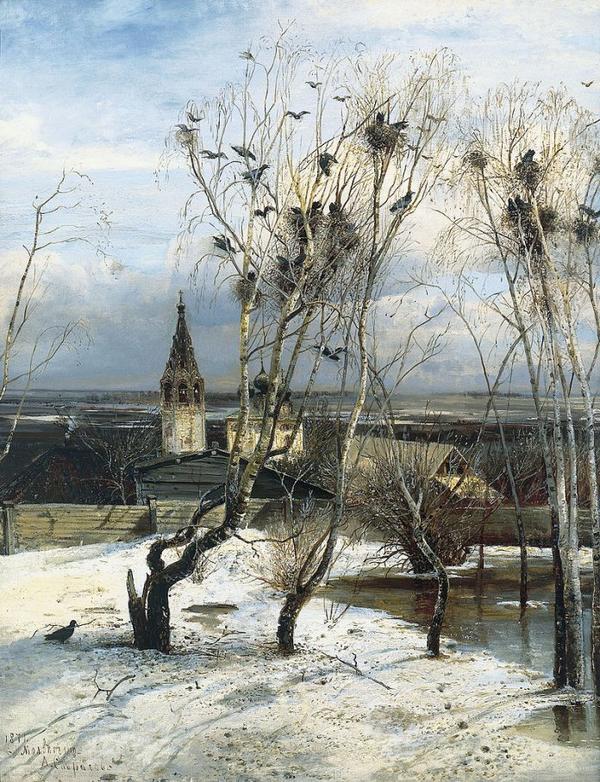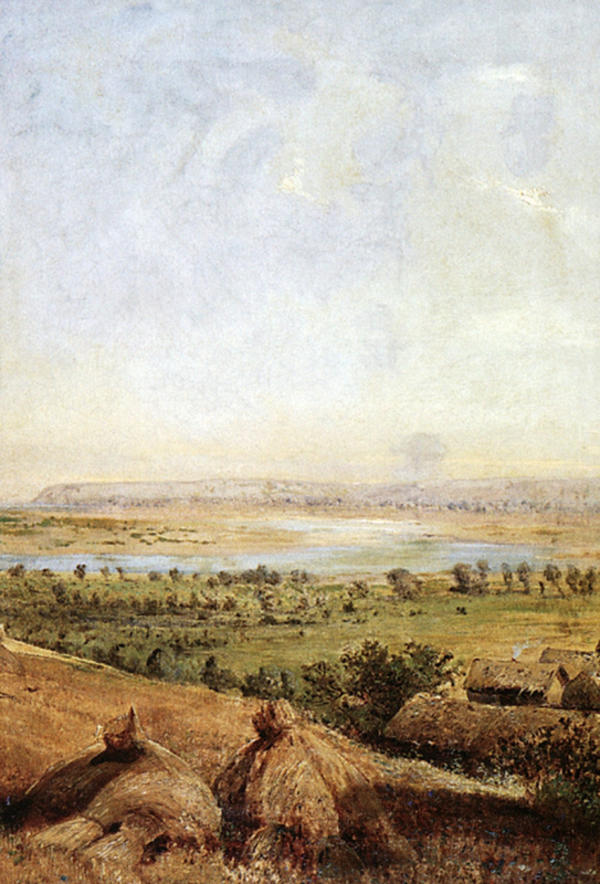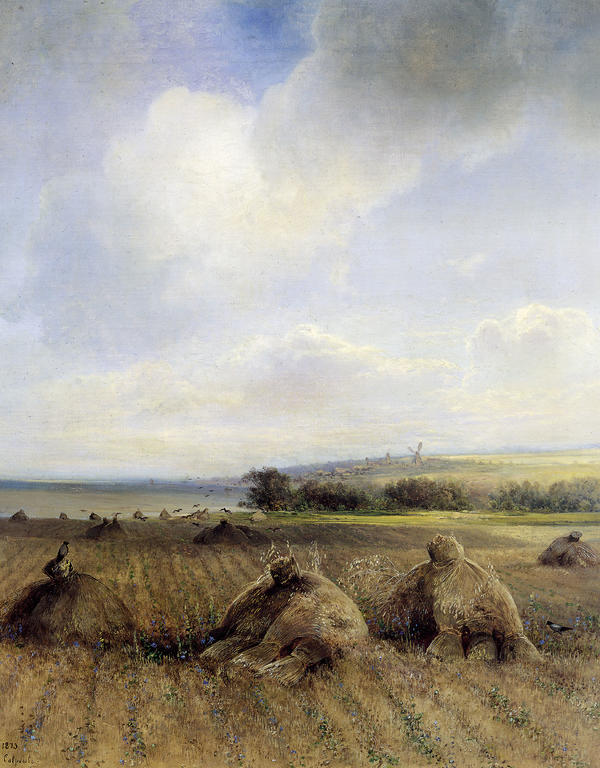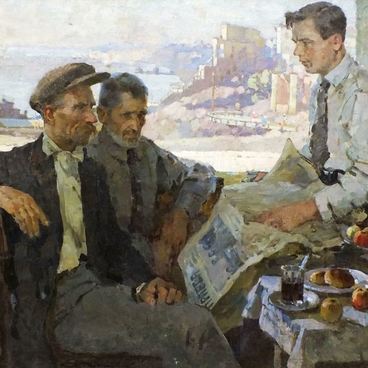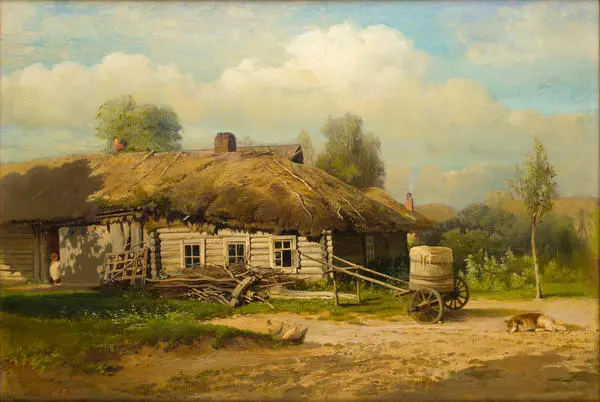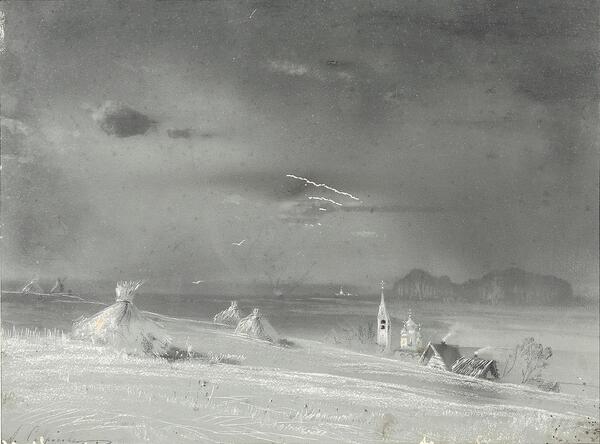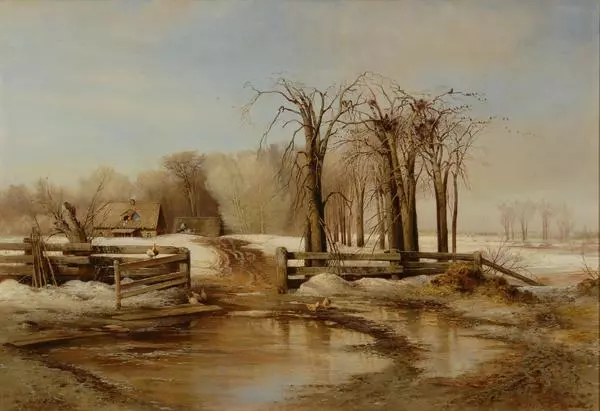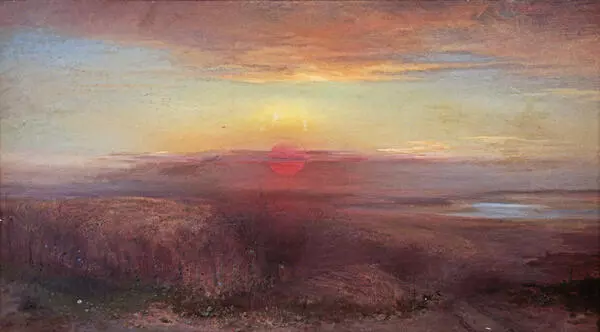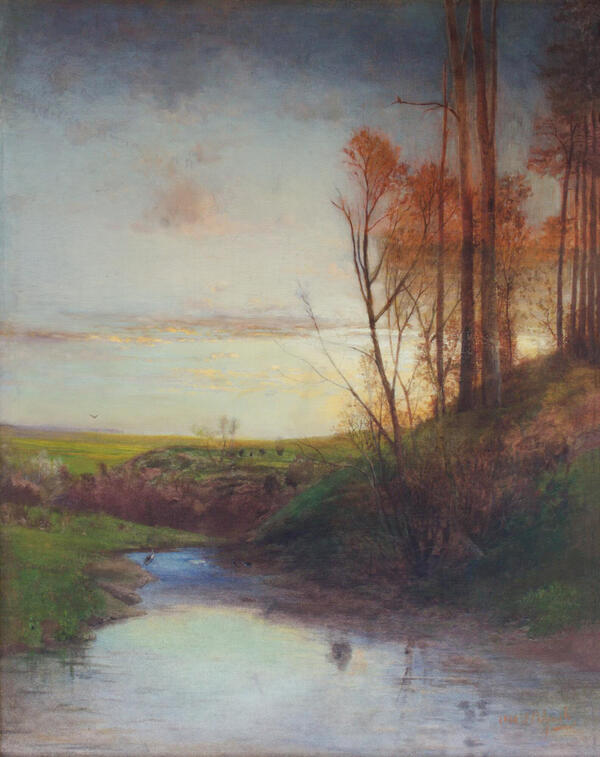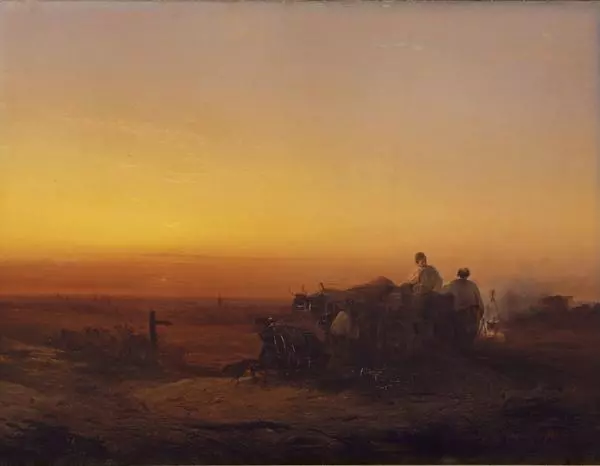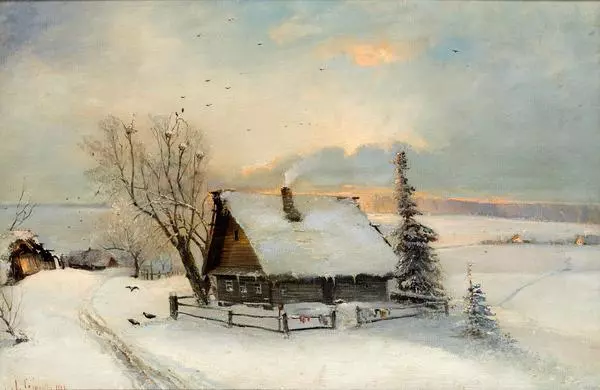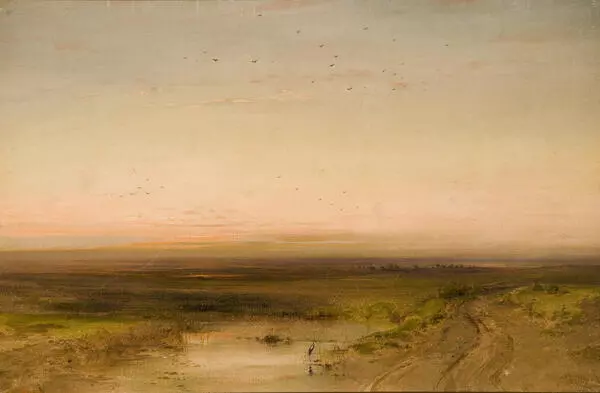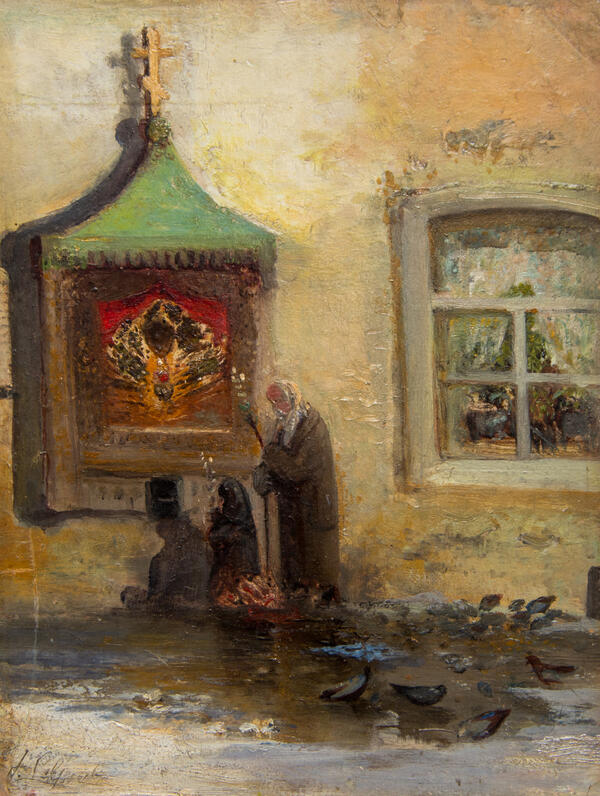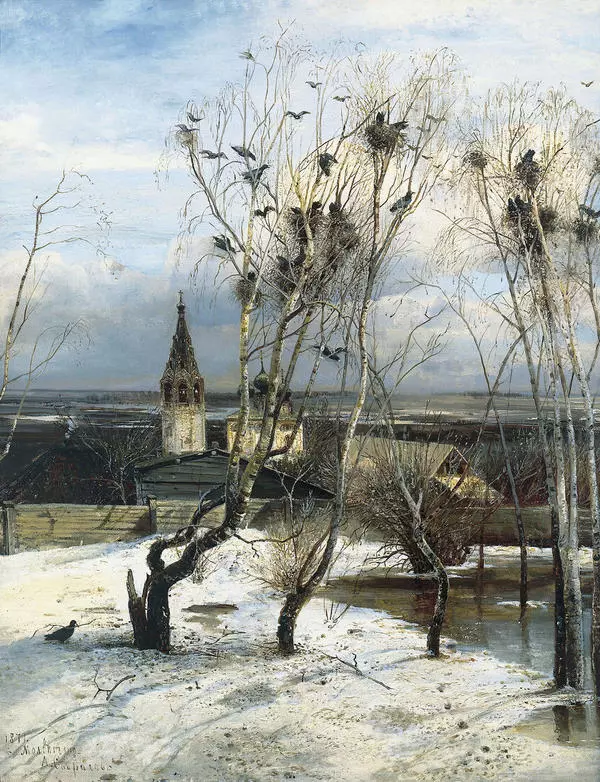The artist Alexey Savrasov is considered ‘the first Russian lyrical landscape painter’. One of the founders of the Association of Traveling Art Exhibitions, known in the circles of the Moscow intelligentsia from the age of 19, he dedicated the power of his talent to the Russian landscape.
His painting Landscape with a Haystack with birds circling over the hay, with field herbs and a blurred strip of a field, clearly conveys the feeling of freshness after a recent thunderstorm. The glimpses of puddles left behind by the rain in the dark soil seem to still contain the grim power of the raging element. The elements are already non-hazardous, firmly closed between the fresh greenery in the foreground and wide strip of sky full of shades of blue, with the whiteness of sun-drenched dissipating thunderstorm clouds.
The future artist Alexey Savrasov was born in Moscow in 1830 in the family of a haberdashery merchant. He discovered a craving for painting. At the age of 12 years old, he taught himself the basics of artistic skill, did watercolor landscapes, which he sold without difficulty at an expensive price on the Nikolsky market. The artist’s father, Kondratiy Savrasov, did not approve of his son’s hobby as it ruined his hopes for the continuation of the family business. That is why Alexey Savrasov had to pay the tuition fee at the Art School of Painting and Sculpture with his own money that he had earned by selling his first watercolors with copies of romantic stories from magazines.
Savrasov was lucky to learn from the artist Carl Rabus. The teacher helped not only to master the skills, but also to go on a trip to Ukraine. There, the young artist created canvases for which Moscow critics called him ‘the hope of Russian art’. Five years after graduating from school in 1850, Alexei Savrasov was a rising artist. In 1854, his painting The Steppe with Chumaks in the Evening was acquired at the exhibition by Grand Duchess Maria Nikolaevna, who invited the artist to spend the summer in her country house near St. Petersburg. For the painting from that trip – A View in the Vicinity of Oranienbaum, 24-year-old Savrasov got the title of Academician.
It was the first period of popularity, and it did not last long. Savrasov was a stranger to the role of court painter. He returned to Moscow, where soon after the death of his teacher Karl Rabus, he became a leader in the landscape class. The next few years the artist spent travelling in Europe and Russia, where he created a number of paintings, among which The Elk Island in Sokolniki stands out for its charming simplicity.
The creatively vibrant period was also short. Soon the artist had to endure the death of three out of five children. He developed health problems.
The most famous work by Alexei Savrasov is considered the painting The Rooks have arrived, 1871. He created it in early 1870 after moving to Yaroslavl. The Rooks turned out to be a short-lived surge of popularity for Savrasov, the last in his not very long life.
Savrasov’s legacy is not confined to paintings. He was a brilliant teacher who brought up a galaxy of Russian artists, including Konstantin Korovin, Mikhail Nesterov and Isaac Levitan.
His painting Landscape with a Haystack with birds circling over the hay, with field herbs and a blurred strip of a field, clearly conveys the feeling of freshness after a recent thunderstorm. The glimpses of puddles left behind by the rain in the dark soil seem to still contain the grim power of the raging element. The elements are already non-hazardous, firmly closed between the fresh greenery in the foreground and wide strip of sky full of shades of blue, with the whiteness of sun-drenched dissipating thunderstorm clouds.
The future artist Alexey Savrasov was born in Moscow in 1830 in the family of a haberdashery merchant. He discovered a craving for painting. At the age of 12 years old, he taught himself the basics of artistic skill, did watercolor landscapes, which he sold without difficulty at an expensive price on the Nikolsky market. The artist’s father, Kondratiy Savrasov, did not approve of his son’s hobby as it ruined his hopes for the continuation of the family business. That is why Alexey Savrasov had to pay the tuition fee at the Art School of Painting and Sculpture with his own money that he had earned by selling his first watercolors with copies of romantic stories from magazines.
Savrasov was lucky to learn from the artist Carl Rabus. The teacher helped not only to master the skills, but also to go on a trip to Ukraine. There, the young artist created canvases for which Moscow critics called him ‘the hope of Russian art’. Five years after graduating from school in 1850, Alexei Savrasov was a rising artist. In 1854, his painting The Steppe with Chumaks in the Evening was acquired at the exhibition by Grand Duchess Maria Nikolaevna, who invited the artist to spend the summer in her country house near St. Petersburg. For the painting from that trip – A View in the Vicinity of Oranienbaum, 24-year-old Savrasov got the title of Academician.
It was the first period of popularity, and it did not last long. Savrasov was a stranger to the role of court painter. He returned to Moscow, where soon after the death of his teacher Karl Rabus, he became a leader in the landscape class. The next few years the artist spent travelling in Europe and Russia, where he created a number of paintings, among which The Elk Island in Sokolniki stands out for its charming simplicity.
The creatively vibrant period was also short. Soon the artist had to endure the death of three out of five children. He developed health problems.
The most famous work by Alexei Savrasov is considered the painting The Rooks have arrived, 1871. He created it in early 1870 after moving to Yaroslavl. The Rooks turned out to be a short-lived surge of popularity for Savrasov, the last in his not very long life.
Savrasov’s legacy is not confined to paintings. He was a brilliant teacher who brought up a galaxy of Russian artists, including Konstantin Korovin, Mikhail Nesterov and Isaac Levitan.


